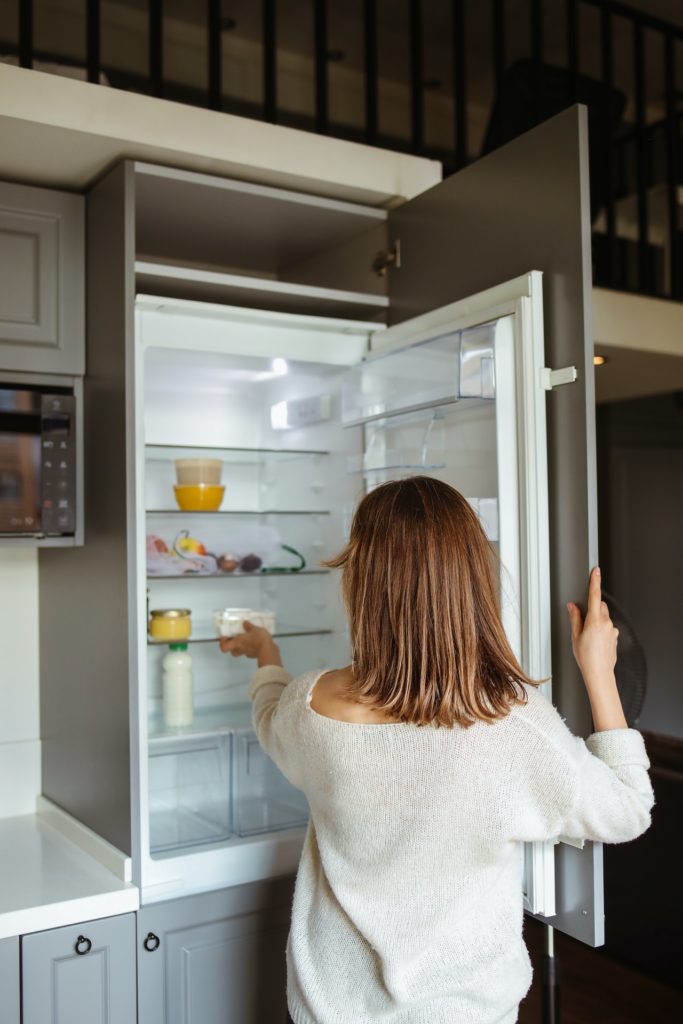
How does a refrigerator cool food? By transferring the heat from inside the refrigerator to outside using evaporation.
Fresh foods have to be kept cool to make them last longer. As soon as they are opened, or cut, bacteria start to decompose them. When foods decompose, they taste bad, but some bacteria can produce toxins when they break down food and these toxins can be very dangerous for us. There are four ways to keep food edible for longer. You can pickle or salt the food. Bacteria can’t survive in very salty conditions or very acidic conditions. You can dry the food. Bacteria need water to reproduce. You can cook the food. Many bacteria can’t survive over about 60℃ and even the hardiest bacteria can’t survive above 138℃, which is the temperature UHT milk is prepared at. Or, you can chill the food. Most bacteria can’t reproduce at lower than 5℃. A refrigerator generally keeps the things inside it at 4℃.
The first electric refrigerator was invented in 1913. Before that, people used to keep food cool by using an ice box. An ice man would deliver ice to a house and it would be kept in the ice box. If the ice box was insulated well enough, the ice would stay solid for a long time and the food would be kept chilled until the ice man’s next visit. Before people had ice boxes in their houses, some rich people would have an ice house somewhere in the grounds of their house where the ice could be kept and foods that spoil easily could be stored. Before people could use ice boxes and ice houses, they would salt, dry, or pickle food and if they couldn’t do that they would eat as much as possible while it was still fresh.
So, how does a refrigerator cool food? There are seven parts that go together so that the refrigerator can cool the food. We need a compressor, a condenser, an expansion device, an evaporator, a thermostat, a coolant liquid, and the box of the refrigerator.
The refrigerator box is the first thing that we see because everything else is hidden behind or under it. The early ice boxes were wooden boxes that were insulated with tin or zinc. They were extremely heavy. With the invention of plastics, the inside of a modern refrigerator is insulated with rigid polyurethane foam. It is made up of lots of small cells that are very dense. They cannot move and cannot remove energy from a system or add energy to it, which is how heat is transferred.
The blood of the refrigerator is the coolant that goes around in the pipes. These days the most commonly used coolant is isobutane. Refrigerators used to use freon, but it was discovered in the 1980s that freon and CFCs were responsible for the hole in the ozone layer and they were banned in 1987.
At the base of the refrigerator is the compressor. This is a motorized pump that has two jobs. It has to pump the coolant around the refrigerator and it has to heat the coolant. The coolant enters the compressor as a low-pressure gas. The compressor heats the coolant by compressing it, hence its name: compressor. As the pressure in the compressor increases, the atoms in the liquid isobutane get more energy and they start to move more. They become very hot and they become a high-pressure gas.
The high-pressure gas is forced from the compressor into the condenser. Again, as its name suggests, the condenser is where the coolant condenses. The condenser is made of a long, coiled metal tube. It is long to increase its surface area and it is made of a highly thermal-conductive metal, usually a copper-nickel alloy. The hot, high-pressure gas enters the condenser, and the metal conducts the heat from the gas and expels it into the atmosphere. This is why the back of a refrigerator feels so hot. The gas must be hotter than the surrounding air so that the heat transfer can take place. If the weather is unusually hot, the refrigerator will have to heat up the gas even more and you will be able to feel the heat coming from it. As the gas loses its heat energy, it turns back into a liquid, but it is still at the same high pressure.
The high-pressure coolant flows from the compressor into the expansion device, which is attached to the evaporator on the other side. The expansion device is a thin pipe that leads into a slightly widened bulb that connects to the evaporator. The evaporator is another series of metal pipes, but this time they are inside the fridge. When the liquid coolant enters the expansion device it is at a very high pressure. The evaporator on the other side of the pipe has a low pressure because the compressor is sucking the air out of it. When the coolant moves into the low-pressure evaporator its pressure rapidly drops, which reduces its boiling point. In this state, the coolant only needs to absorb a small amount of heat energy to evaporate and become a gas. The coolant absorbs the energy out of the inside of the refrigerator, turning it into a cool, low-pressure gas. This gas carries the heat from the inside of the fridge away and is then pumped back to the compressor, where the whole process repeats itself.
So, what of the thermostat? That is the control for the compressor. If the temperature in the fridge is too low, it switches the compressor off. If the temperature is too high, it switches the compressor back on again.
So, how does a refrigerator cool food? By evaporating a low-pressure liquid inside the refrigerator to absorb the heat energy from inside the fridge. And this is what I learned today.
https://en.wikipedia.org/wiki/Freon
https://en.wikipedia.org/wiki/Isobutane
https://www.materials.sandvik/en/campaigns/fridge-of-the-future/the-history-of-the-refrigerator/
https://blog.synthesia.com/en/behavior-polyurethane-systems-thermal-insulation

